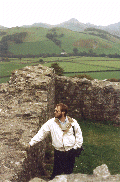



|
 |
 |
|
| writings || books || projects || madvertising || odds & ends || about || bio |
Art & Culture
Auld Lang Syne lessons learned from this profession
ok, I'm not the guy from SNL,
mostly true stories from my more "it's all about me"
I’m at -7.13/-7.33 on The
Political Compass. Where observations on the human condition take a trip with me
|
Published in the Columbia Daily Tribune 16 April 2006
Ammanford Sculpture ControversyThe new public sculpture has generated a lot of controversy. I don't see why. Two tall triangles of stacked stone slabs, curving to embrace one another, echoing the surrounding mountains . . .Surrounding mountains? . . . creating a narrow crack in the earth, inviting the viewer to enter and experience what it must have been like for the coal miners. The tops of the triangles end in semi-circles, making a negative space for the great wheel of a mine head. The sandstone is layered with slate, representing the seams of coal. And on the bands of stone are engraved descriptive words and poems in both English and native Welsh . . . Welsh? What? Wait a second. Toto, we're not in Columbia anymore, are we? No, we're not. Last month my wife and I were on vacation in Wales, a rural part of the UK filled with wonderful castles, beautiful mountains, and a surprising amount of good art. One of the towns we visited was Ammanford, Carmarthenshire, in the southern part of the country. We met a friend who lives there, and who was happy to show us around. On our tour we stopped by a new sculpture by Welsh artist Howard Bowcott, commemorating the area's mining tradition. (100 years ago Wales was the 'Saudi Arabia' of anthracite coal - the form of energy most in use around the world at the time). It's a beautiful modern sculpture, some 20' tall, and should be a source of pride for the community. Of course, like modern art here in Columbia, it is instead a source of ongoing controversy. Coverage in the local paper was titled "Masterpiece or Monstrosity?", and said that the paper had been inundated with complaints about the waste of taxpayer money that went into funding the work. Several people thought the monument should be a traditional bronze statue of a miner, that that was the best way to honor the history of the region. You can see some of the comments here. My friend, Siôn Woods, likes the sculpture. "I believe that the new monument is very eye-catching and is, in fact, very informative as well as a symbol of our local history and culture. I use the word 'informative' because of the use of mining terms which are engraved into the stone. Since the virtual disappearance of the mining industry, which was such an integral part of the area, the younger generation is growing up with little or no knowledge of the importance of the industry in the past. The special terms used by colliers - in English and Welsh - are being forgotten. Personally, I found the use of vocabulary on the memorial an excellent way of preserving those terms. They are placed within the lower strata of the rocks which evokes the use of both languages in the workplace below ground." Siôn isn't an artist. He's a linguist and a teacher, and understandably proud of the heritage of his town and country. But I have to completely agree with his assessment of the sculpture. Without knowing much of the town's history, without knowing anything about the sculptor, I instantly understood what the artist was trying to convey in his work. This is what is the measure of any work of art. Not whether it fits into the pre-conceived notions of what is "suitable" or traditional. But whether it conveys a meaning, a message, an emotional response which is understandable across class and culture. Like our selection process for publicly-funded works of art, there are governmental guidelines which must be followed in the UK. Part of those guidelines was included in the minutes of the Ammanford Town Council meeting at which the sculpture was approved: Public art can play an important part in creating or exploiting individuality and raising the profile of our towns, villages and landscape. Focusing public art at key locations, at important junctions, meeting places or entry points can enhance existing townscape features and help make the area more legible. There is considerable scope for integrating public art into the townscape, ranging from the dramatic to the subtle, from traditional free-standing landmark sculpture to the innovative design of functional objects.I like that last bit, particularly. Public art is OUR art, paid for with OUR money, placed in OUR community. To get the kind of public art we want, we have to partake in the selection process. But we also have to be open-minded about how the art will fit in, and what it will tell visitors about our community. Had the monument in Ammanford been just another statue of a miner, I wouldn't have given it a second look. But Bowcott's sculpture got my attention, told me a lot about the area and the people there, and became a memory of my vacation I will long cherish. |
|
contact me: jim@afineline.org |
all work © James T. Downey, 1993-present photos © Martha K. John, 1994-present |
site designed and maintained by: Coeurbois Graphic Design |